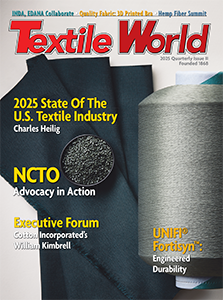LEONBURG, Germany — October 2016 — The Knit Concern Group, founded in 1990, specializes in the production of high-quality warp-knitted and knitted fabric. In the beginning, Knit Concern had about 500 workers. In the meantime the company has grown and is one of the biggest textile producers in Bangladesh. Among other things Knit Concern produces T-shirts, polo shirts, sweat shirts and nightwear for well-known labels such as H&M, Camaieu, Obaibi, Okaidi, We, Mas Intimates and others.
Currently almost 200,000 pieces of clothing are produced each day which means about 35 tons of knitted articles. Knit Concern will enlarge in the near future their production so that they will produce daily 100 tons of textiles. The company aims at becoming the leading producer and exporter of knitted fabric in Bangladesh.
In 2005 Knit Concern bought their first BRÜCKNER stenter. Since that time the company has been continuously growing and the number of Brückner machines in their production grows with it. During the last ten years Knit Concern invested in another ten Brückner lines, among them several tenters, a sanforizing line, a felt calender, a compactor and a relaxation dryer.
The Brückner relaxation dryer is designed particularly for the finishing of open-width fabric, but if required the line can also be used for tubular fabric. Mainly articles made of natural fibers for example cotton or viscose are dryed, relaxed and shrunk on this 2.60-meter- wide dryer. Two padders are arranged in front of the dryer. The first one dewaters the fabric and provides a uniform fabric moisture. The second padder serves mainly for the impregnation of the fabric with plasticizer. Before the fabric passes through the dryer, it is transported through an inclined pre-tentering zone and is overstretched in wet condition. Given a corresponding overfeed of 80 to 100 percent and a width overstretching between 30 and 50 percent the lengthwise distortions resulting from the previous wet processes (washing, dyeing, padding) are reduced. The complete process on the pre-tentering zone serves to pre-relax the fabric which can be shrunk considerably better in the subsequent drying process and which reaches thus minimum residual shrinkage values. Within the dryer the fabric first passes an air-through zone where it is pre-heated. In the following two passages the drying and shrinking process as such begins which takes place by means of a tumble-like fabric movement.
Pre-heating the fabric in the air-through zone has several benefits. On the one hand, this zone is heated up exclusively by the exhaust air of the two drying passages arranged below. This means no additional energy is required. On the other hand the fabric heats faster and requires thus less dwell time in the subsequent drying process. The fabric can pass this dryer faster than other dryers. Another benefit is the reduced exhaust air temperature. This air-through principle developed by Brückner allows energy savings of up to 15 % with a simultaneous increase of production of up to 20 percent, depending on the type of fabric and the machine configuration.
This highly sophisticated Brückner relaxation dryer can be very easily integrated into an existing line concept. Due to the fact that the drying passages are arranged one above the other this line is saving space. Knit Concern understood and estimated the advantages of this machine concept and benefits of the very good and stable residual shrinkage, the high efficiency and the drying performance. About 12 tons of knitted fabric are finished on this line every day.
In addition Knit Concern uses the advantages of the good Brückner service in Bangladesh. A local service team which is trained regularly in Germany or by German technicians and technologists on site supports their customers in Bangladesh during the installation and commissioning of their lines and is at anytime available and arrives if required very rapidly on site. BRÜCKNER has in addition a service station in Dhaka with a large spare parts and lubricants stock. The most important parts are thus very fast available.
“Our vision is to be the country leader in producing and exporting knitted fabric in the export market“, says Joynal Abedin Mollah, MD of Knit Concern Ltd. “Quality Assurance & Product Safety is one of Knit Concern’s main focuses. Therefore we need to have also high-quality machinery in our production and that is one reason for buying Brückner machines. In addition, we have a long-term and strong relationship with Pacific Associates Ltd., Brückner’s agent in Bangladesh. The support and service is always excellent and we can count on the expertise by their technicians at any time.”
Posted October 19, 2016
Source: Brückner




